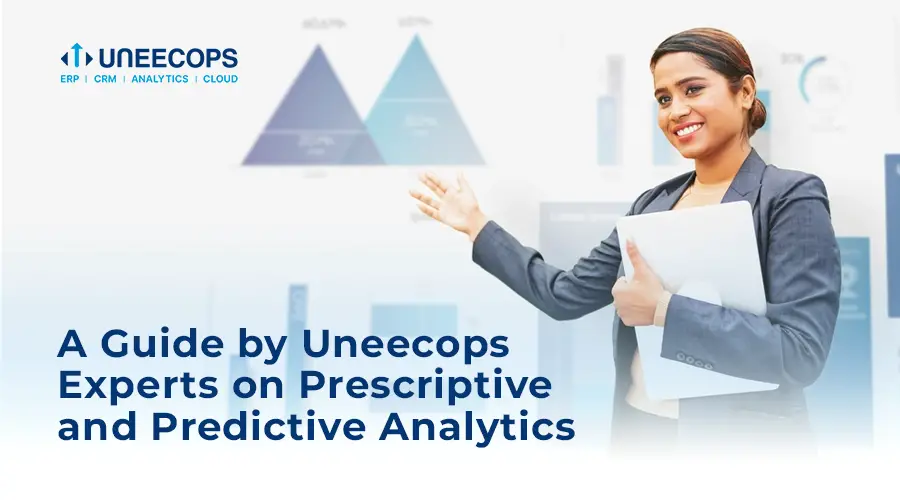Table of Contents

In the world of data analytics, two prominent techniques that help businesses gain valuable insights are predictive analytics and prescriptive analytics. While they may sound similar, there are distinct differences between the two approaches. In this article, we will explore the use cases and benefits of predictive and prescriptive analytics, as well as compare predictive vs prescriptive analytics to reveal their distinctive methodologies.
Prescriptive and Predictive Analytics
Let’s talk about Prescriptive and Predictive Analytics.
Predictive Analytics is like making smart guesses about what might happen next using past information.
Prescriptive Analytics goes a step further. It not only guesses but also gives advice on what actions to take for the best results.
Use Cases for Predictive Analytics (How Companies Use Predictive Analytics)
Sales and Marketing
Predictive data analytics can be used to forecast customer behavior, identify potential churn, and optimize marketing campaigns. By analyzing historical data on customer preferences, purchase patterns, and demographics, businesses can predict customer actions and tailor their sales and marketing strategies accordingly.
Financial Analysis
Financial institutions can leverage predictive analytics to forecast market trends, predict stock prices, and detect fraudulent activities. By analyzing historical financial data and market indicators, businesses can make more accurate predictions about market movements and adjust their investment strategies accordingly.
Operations and Maintenance
In industries such as manufacturing and transportation, predictive analytics can help optimize operations and maintenance schedules. By analyzing sensor data and historical maintenance records, businesses can predict equipment failures, schedule maintenance proactively, and minimize downtime.
Business Analytics Software
Business analytics software, such as Tableau, PowerBI, and Alteryx, provides powerful data visualization dashboard and analysis capabilities, enabling organizations to explore data, build predictive models, and generate insights.
Benefits of Predictive Analytics
Improved Decision-Making
By leveraging predictive analytics, businesses can make data-driven decisions based on accurate forecasts and predictions. This leads to more informed strategies, optimized resource allocation, and improved overall performance.
Increased Efficiency and Cost Savings
Predictive analytics helps businesses identify inefficiencies, bottlenecks, and areas for improvement. By optimizing processes, businesses can reduce costs, increase operational efficiency, and maximize profitability.
Enhanced Customer Experience
By understanding customer behavior and preferences through predictive analytics, businesses can personalize their offerings, provide targeted recommendations, and improve the overall customer experience. This leads to increased customer satisfaction and loyalty.
Use Cases for Prescriptive Analytics (How Companies Use Prescriptive Analytics)
Supply Chain Optimization
Prescriptive data analytics can optimize supply chain operations by considering various factors such as demand, inventory levels, transportation costs, and production capabilities. It can recommend the most efficient routes, inventory levels, and production schedules to minimize costs and maximize customer satisfaction.
Healthcare Management
In the healthcare industry, prescriptive analytics can help optimize patient care and resource allocation. By analyzing patient data, medical histories, and treatment outcomes, prescriptive analytics can recommend personalized treatment plans, optimize staffing levels, and improve overall healthcare delivery.
Financial Planning and Risk Management
Prescriptive analytics can assist in financial planning and risk management by recommending investment strategies, portfolio allocations, and risk mitigation measures. By analyzing market data, economic indicators, and risk profiles, businesses can make informed decisions to maximize returns and minimize risks.
Benefits of Prescriptive Analytics
Optimized Decision-Making
Prescriptive analytics provides businesses with actionable recommendations, allowing them to make optimal decisions and achieve desired outcomes. It considers various constraints, objectives, and scenarios to recommend the best course of action.
Improved Efficiency and Resource Allocation
By optimizing processes, resource allocation, and decision-making, prescriptive analytics helps businesses improve efficiency, reduce waste, and allocate resources effectively. This leads to cost savings and improved overall performance.
Enhanced Strategic Planning
Prescriptive analytics enables businesses to develop and refine their strategic plans by considering various scenarios, constraints, and objectives. It helps in identifying the best strategies to achieve business goals and stay ahead of the competition.
Key Differences Between Predictive and Prescriptive Analytics
When it comes to analytics, understanding the difference between predictive and prescriptive analytics is crucial. When we compare descriptive and predictive analytics, it becomes evident that their core purposes and methodologies diverge significantly. Comparing prescriptive vs predictive analytics reveals their distinctive methodologies:
- Focus: Predictive analytics tries to guess what will happen next using historic information. While prescriptive analytics goes a step ahead by giving suggestions on what to do to make those future results even better.
- Actionability: Predictive analytics gives ideas about what might happen, but it doesn’t tell you what to do. Prescriptive analytics does more – it gives advice on what actions to take based on what might happen.
- Complexity: Prescriptive analytics is more complex and sophisticated than predictive analytics. It utilizes advanced algorithms, machine learning techniques, and optimization models to determine the best course of action.
- Decision-making: Predictive analytics helps businesses choose wisely using good guesses about the future. While prescriptive analytics helps businesses choose the very best by suggesting exactly what to do to get the results they want.
Make Decision-Making More Intelligent with Uneecops
Yes, predictive and prescriptive analytics are powerful tools that businesses can use to gain insights, make informed decisions, and optimize outcomes. Predictive analytics tries to predict what might happen, while prescriptive analytics goes even beyond that. It not only predicts but also suggests what actions to take to get the results you want. When businesses use these methods, they can work better, make smarter choices, and stand out in the world where data is important.
Uneecops combines intelligence services and data analytics tools to automate repeatable decisions and gain a competitive advantage. Our scalable analytics services and strong hold over intelligence solutions help clients gain tangible results and achieve business goals. Discover how Uneecops is augmenting business functions for clients across different industries in achieving the required analytics maturity and accomplishing business outcomes.






More Stories
10 merek aksesori smartphone terbaik di tahun 2024
7 motor sport paling terkenal dan mahal di dunia
10 Hotel di singapore yang menawarkan fasilitas mewah